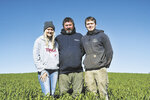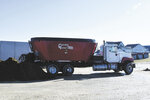

FOUNTAIN, Minn. — Mulhern Dairy is feeding 1,050 cows using a ration that excludes alfalfa.
Greg and Corey Mulhern dairy farm near Fountain. They milk three times a day in a double-14 parallel parlor and are assisted by 12 full-time employees.
After removing alfalfa from the ration, Corey Mulhern said they have seen fewer cows off feed, better rumination, increased butterfat content, and improved soil health and organic matter. He also can use all of his acres to spread manure and has more flexibility on cut times for forage quality.
In 2020, the farm began the transition as they gradually phased out their acres planted in alfalfa. In 2023, there were no remaining acres of alfalfa.
“We’re looking at feed quality and digestibility, which I feel are a lot better than haylage,” Mulhern said. “The other big kicker was I was always short on acres for manure, and now, every acre is available for manure every year.”
The Mulherns have about 1,300 acres to raise all their feed. They plant 600 acres for corn silage, 400-500 acres of annuals for forage and the balance for soybeans or corn as grain.
The rotation varies. Sometimes they plant corn for two years and then plant an annual for forage. Other times, they alternate corn with annuals. Regardless of the crop raised, they aim for similar tons of dry matter per acre.
“Coming in with these annuals after a winter cover crop, we can hang right at that 8 tons of dry matter per acre which is really close to corn,” Mulhern said. “(We) should consistently stay at 8 tons of dry matter off every acre every year. So, I was more focused on tons per acre.”
The Mulherns have been planting cover crops for 7-8 years. Their cover crops include winter rye, which is fed to heifers, and winter triticale, which is fed to the dairy herd.
“I really like feeding the winter triticale to cows,” Mulhern said. “Cows really seem to milk. ... The cows would milk just as good off that as they did with haylage.”
However, when he planted corn after triticale, Mulhern found the tonnage he gained on the triticale was lost on corn yields. Planting an annual mix instead helps with this.
Mulhern uses two annual mixes. Each has different planting and cutting schedules.
Mulhern plants Dairy Max Annual Cocktail mix in April on soil with no cover crops growing. He cuts it every 30 days and will get four cuttings in a season. The mix contains Italian ryegrass, medium red clover, berseem clover and hairy vetch. He plants it with a cover of forage oats.
Mulhern’s other annual mix is Yield Max. It is planted after a cover crop is harvested. Mulhern lightly tills, drills in the mix and rolls the ground.
Plant time for this mix is approximately June 1 when the soil temperature is 60 degrees. The mix contains brown mid-rib sorghum-sudangrass, Italian ryegrass, medium red clover, berseem clover and hairy vetch.
Mulhern cuts this mix for the first time at 45 days. His second cutting interval is 30 days, and his final interval is 45 days.
Mulhern chops both mixes and stores them in bunkers. Mulhern said the annual mixes dry faster than alfalfa. A field cut in the morning can be chopped the next afternoon.
Mulhern also said the summer annuals are more flexible on cut times than alfalfa.
“If you run into some weather on either one of these, you are not going to lose much feed value like you do on an alfalfa,” Mulhern said.
Unlike alfalfa, he said the summer annual mix is not quick to have butyric acid. Forage put up at 65%-70% moisture does not suffer from a concentration of butyric acid like haylage.
In the fall, Mulhern plants cover crops within a couple of weeks of harvesting corn. He leaves his summer annuals to grow as a cover crop over winter.
If he does not have to spread manure on those acres, he will no-till corn into the remaining annuals mix in the spring.
Mulhern said that the annuals mix has positively impacted soil health.
“(There are) a lot of positives,” Mulhern said. “The organic matter with all the roots, the root system breaking up compaction, it’s done a lot.”
Mulhern’s herd eats a 60% forage diet. His milking herd ration contains about 22 pounds of corn silage and 9 pounds of annuals.
Mulhern said the digestibility of the annuals is excellent. He said they are sometimes too digestible and he is forced to include straw.
Rumination has also increased 50-70 points, according to the SCR Heatime system the cows wear, after the switch to no alfalfa.
“My off feeds drastically went down when we weren’t feeding alfalfa,” Mulhern said. “Our rumination would go up on the ... activity system, and our off feeds would go down.”
Mulhern has also seen an increase of 0.10% in the herd’s fat test. His herd averages 90 pounds of milk with tests of 4.75% butterfat and 3.4% protein.
Mulhern’s nutritionist, Chad Kieffer, introduced the Mulherns to Daniel Olson of Forage Innovations, who shared the concept of removing alfalfa. Olson uses forage mixes in rations across the U.S. The Mulherns believed in the concept when Olson shared it during a farm visit.
“He’s an honest guy,” Mulhern said. “He’s doing it on his own farm. I’m always looking outside the box, looking for new ideas, willing to try about anything.”
Comments
No comments on this item Please log in to comment by clicking here